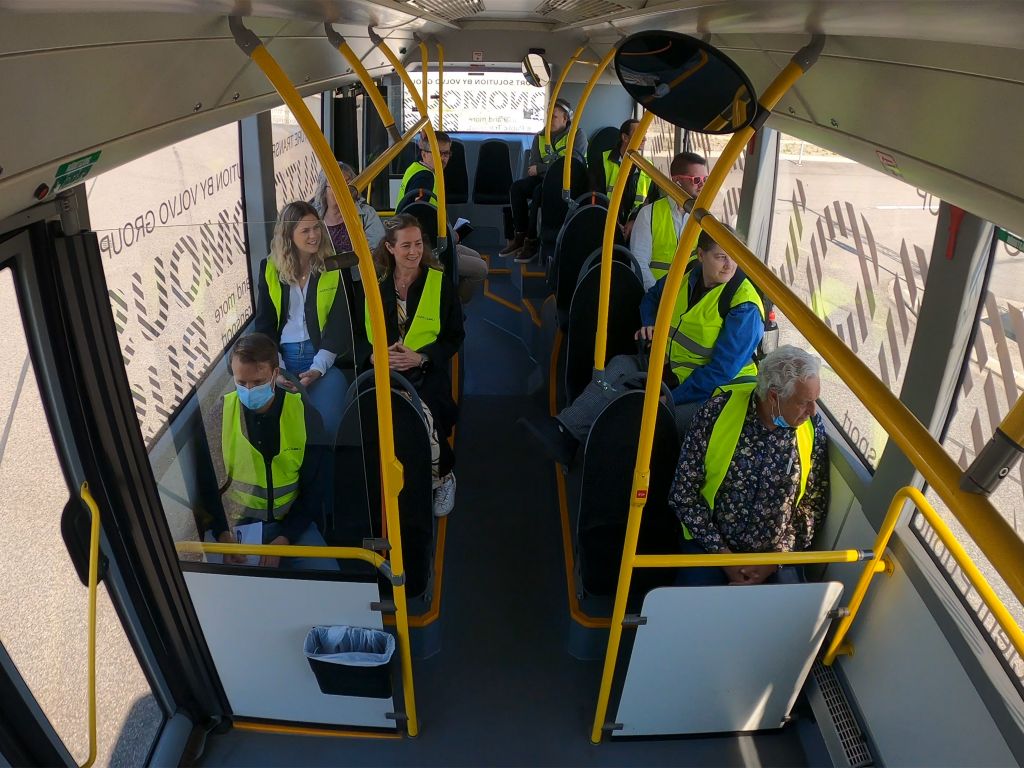“Who dares to ride a self-driving bus?”


“I didn’t think too much about the fact that there was no one behind the wheel, it was like a normal bus ride. The bus ran very smoothly and was not as jerky as I thought it would be,” says Elin Wadström.
She has just taken her first trip on a self-driving bus as part of a unique study initiated by Volvo Buses and Västtrafik and conducted by researchers at Chalmers University of Technology. The purpose is to find out how passengers experience riding on a self-driving bus and how they think the technology can affect future mobility.
In the study, 22 public transport passengers rode a self-driving Volvo bus on the AstaZero test track and experienced how it handled different traffic situations along the way. The bus navigated a roundabout, picked up a passenger from a bus stop and encountered a car, cyclist and a pedestrian with a pram.
“I think the bus handled all traffic situations very well. For me as a passenger, it felt safe. I trust that the technology does what it is supposed to,” says Elin Wadström.
The study shows that the other passengers also had a positive experience. The vast majority felt safe and thought that the bus ran calmly and smoothly. “The biggest difference from riding with a driver was that it drove slower in all test situations. Having said that, it was as uneventful as you want a bus trip to be,” says Björn Åsman, one of the other participants.
Many of the passengers in the study can also see the benefits of self-driving buses, such as increased safety and comfort. At the same time, they do not believe that the technology itself will affect their own commuting habits.
“I take the bus every day and I would have done it anyway, regardless of whether there is a driver behind the wheel or not. The big difference will probably be if there are more self-driving vehicles, then public transport can probably be more efficient and entice me to travel more often,” says Björn Åsman.
Conducted with its 12-metre bus for city traffic, the passenger study is the first of its kind and provides important insights into Västtrafik’s and Volvo Buses’ work in developing future mobility solutions. “Even though completely self-driving buses in public transport are a long way off, it is important for us to know how our passengers experience the technology. The fact that they did not think it was such a big deal is one of the insights we take with us. As long as we can offer a safe and secure journey, maybe self-driving buses are not as big a change for our passengers as you might think,” says Mikael Faleke, project manager at Västtrafik.
Joakim Jonsson is responsible for researching autonomous solutions at Volvo Buses. “The passengers’ feedback is incredibly valuable to us, and I am impressed that they had so many insightful answers and comments,” he says. “A question I often get in my job is ‘who dares to ride a self-driving bus?’ Now we know. The participants agreed to take part in the study without knowing what they would experience. Despite that, everyone chose to go with it and they thought it was a positive experience. We believe that in the future this will also be the case for the general public.”
About the research project
The study Passengers’ Experience of Travelling with a Full-Length Automated Bus and Expectations of the Future Public Transport System was initiated by Volvo Buses and Västtrafik and conducted by researchers at Design & Human Factors at the Chalmers University of Technology. The research is part of Drive Sweden's KRABAT project, which is partly financed by Vinnova. The technical solution has also been supported by the Strategic Vehicle Research and Innovation Programme (FFI).
How the study was conducted
The study involved 22 people of different ages who travel by bus daily.
In order for them not to have the opportunity to prepare or research the topic beforehand, they were first told what the study was about when on location.
The study took place at AstaZero, a closed-off testing facility for future road safety.
Passengers rode on the self-driving bus as it covered a set route and experienced nine different traffic situations. There were three test leaders on board the bus.
The participants had to answer both written and oral questions about how they experienced the bus and the driving. They were also asked questions about how they see the future of public transport.